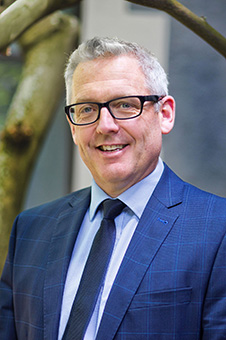Tackling climate change through a world-first nationwide collaboration of all publicly-funded tertiary education institutions is an award-winner for New Zealand – and the University of Otago.
The initiative has won the Powerful Partnerships category of the 2024 Australasian Green Gown Awards, and is a highly replicable model other sectors and countries can follow, Otago Sustainability Office Head Ray O’Brien says.
All New Zealand’s universities, Wānanga, and Te Pūkenga (Institute of Skills and Technology) worked together to assess how global warming could affect their sector to 2100, setting a global standard for education climate planning.

Ray O'Brien
The sector can now plan for climate change with a common understanding of the risks – crucial for coordinated and effective action – while meeting individual institution’s needs, he says.
Having climate change scenarios encourages tertiary leaders to plan for the environmental and social risks, which could reduce the sector’s vulnerability. This is critical because the sector educates the country’s leaders, houses vast knowledge, and is a critic and conscience of society.
Having a clear framework also helps to alleviate eco-anxiety among students, staff, and the broader community.
The Government does not currently require the tertiary sector to report on climate adaptation, but the sector decided to be proactive.
Developing the scenarios took six months and involved more than 100 people, including in-house expertise, government agencies, and industry experts. Two workshops were held in five locations across New Zealand as a combination of in-person and virtual attendance, Ray says.
He was a member of the advisory group that led the initiative while Otago’s Strategy, Analytics and Reporting Director David Thomson was a sponsor.
The four climate scenarios the sector developed were Sweet As to Oh Bugger! Ray says they provide a diverse range of futures to test-drive the Aotearoa tertiary sector without predetermining which is most likely or desirable, as they are all plausible.
In the Sweet As scenario, while global temperatures still rise by 1.5°C, a planned social transition aims to deal with challenges that include regular floods, threats to aquaculture, invasive weeds, and food becoming scarcer and more expensive – such as red meat and milk – because land use switches to regenerative trees, cereals, fruit and vegetables.
In this scenario, the tertiary sector could provide practical solutions for reducing carbon emissions and its climate change adaption research attracts increasing funding, e.g. suitable crops, combating invasive pests and coastal erosion, and protecting native flora and fauna.
But overall, in a Sweet As future, tertiary funding could drop as the Government battles climate change and student numbers decrease with birth rates, prompting the sector to start working together – instead of competing – to provide regional centres offering nearly all the same qualifications.
Students attend their local centres and choose from more qualifications, ranging from two-year intensive courses to up to seven years’ long for people also working.
In the Oh Bugger! scenario, a 3°C temperature increase and unplanned social response could involve more severe flooding and wildfires, clean water getting scarcer, continuous food price increases, high inflation, boosts in insurance costs, fewer jobs and international strikes affecting supply deliveries.
More people might work remotely so retail could move from major city centres to satellite centres, which also become entertainment hubs.
In this scenario, the tertiary sector could become more commercialised, with elite education centres attracting international attention and tertiary research spaces being privatised and staffed by high-quality academic climate refugees.
The tertiary sector funding that is available is used to teach practical skills and serve a steady flow of climate change refugees. Fewer students studying in-person and fulltime means only the best teaching spaces and accommodation are retained, the rest are sold, repurposed or left dormant.
Reflecting on the scenario creation process, Ray says, while looking so far ahead brings in significantly more uncertainty than most people are used to, failing to look at far horizons and being prepared to speculate about the future only pushes us closer to less desirable scenarios without being prepared.